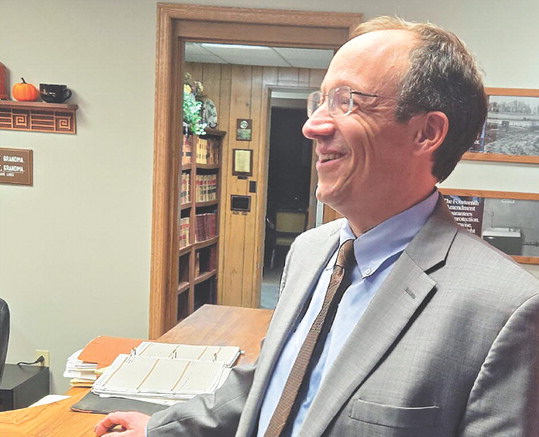Childcare shortage


Marathon county officials search for solutions
Marathon County’s elected officials continue to grapple with the issue of childcare availability, but so far, no policy proposal has been put forward to address the problem.
Members of two county committees discussed the issue last week with representatives of a coalition formed last year that is developing a plan for making child care more accessible and affordable for working families. The group has set November 1 of this year as a deadline for establishing “alternative childcare business models in Marathon County, partnering local employers with childcare providers.”
The group, which includes county administrator Lance Leonhard and public health educator Aaron Ruff, is being funded by a $75,000 Dream Up! grant from the Wisconsin Department of Children and Families. Of that amount, $60,000 is being distributed directly to 12 childcare providers ($5,000 each) in the county to help with staff retention, supplies and equipment or minor renovations.
However, the group’s longterm goal is to find more permanent sources of revenue for struggling daycare operations and encourage partnerships between public and private entities interested in providing affordable childcare.
Ruff said group members have learned a lot in the past six months about the causes of the childcare shortage and are committed to “turning the curve” on declining childcare options in the county.
“If someone in our community wants to work and enter the workforce, they should be able to have access to childcare so they can do that,” he said at a Health and Human Services Committee meeting on March 1.
The Dream Up! team looked at two main indicators to evaluate childcare availability: the number of regulated operations in the county and the number of slots open for children. Both numbers have been on a steady decline since at least 2010, according to data from the group.
Marathon County has about 8,000 children between the ages of 0 and 4, but only 3,400 daycare slots were available in 2022. At the same time, the number of licensed or regulated childcare operations has fallen by 161 over the past 12 years, from 244 in 2010 to just 83 last year.
“So, we’re definitely trending in the wrong direction,” Ruff said. “We’re losing licensed childcare providers every year.”
Ruff said the impact on the local workforce is “profound,” with many parents having to quit their jobs to stay home with their kids.
Micki Krueger, assistant director of Childcaring, Inc. referral service, said the Dream Up! group is most interested in increasing the number of regulated childcare operations, which include both group centers and home-based providers either licensed by the state or certified by the county’s Department of Social Services. Although non-licensed providers – such as relatives and neighbors – are common in the county, they do not have to meet safety standards and cannot accept as many children (four is the legal maximum).
Leonard, however, said the group’s overall goal is to increase the number of options for working families, so they can find a provider that best suits their needs.
“We’re not trying to say that ‘Hey, everyone needs to go into licensed childcare,’” Leonard said.
The single biggest challenge for licensed providers is attracting and retaining staff, who make an average of under $13 per hour and can often get better-paying jobs in other industries, Leonhard said.
Several members of Dream Up! group said the business model for childcare operations is “broken,” simply because providers cannot charge what they need to pay their workers a living wage and meet other expenses. If they do raise their rates, it becomes unaffordable for families.
Elsa Duranceau of the Northcentral Wisconsin Workforce Development Board said the true cost of caring for an infant is $1,800 a month, but very few parents can afford that.
“Putting that burden on the families is not the correct answer,” Ruff said. “It’s a huge expense.”
One alternative childcare model with some record of success involves larger employers contracting with providers to guarantee a certain number of slots for their employees’ children. In Langlade County, for example, the Antigo Child Care Center has been offering reserved spots for the local school district and private businesses willing to pay for spots.
As an entity that employs nearly 800 people, Leonard said Marathon County could look into a similar partnership with a local childcare provider for employees. He said finding daycare is often a challenge for county employees, mentioning one worker who faced waiting lists of up to two years.
Duranceau said having a childcare center for county employees is an “awesome” idea, but she also noted that the industry is fragile, so the introduction of a new facility with better wages could be detrimental to other providers who would lose workers. She said the top priority needs to be investing more money in existing childcare operations.
Kelly Borchardt, executive director of Childcaring, Inc., listed several counties in Wisconsin that are considering the use of federal money from the American Rescue Plan to provide start-up money for childcare centers and hiring incentives for workers.
Supervisor Ron Covelli, a member of the Health and Human Services Committee, said he would rather look at changing regulations and mandates related to childcare than committing tax dollars to providing those services.
“As a policy-making board, I think that’s where we need to start,” he said.
Supervisor David Baker, a member of the Extension, Education and Economic Development Committee, questioned the notion of childcare as “a common good” that needs to be subsidized by the government.
“Traditionally, I believe that it’s been the parents’ responsibility to provide childcare. It has not been a common good,” he said. “I don’t think that mindset is necessarily agreed to by most of our constituents, and even by our county board members.”
Duranceau, however, said dual-income families have needed childcare options ever since the post-WWII era, and many doctors and other specialists would not be able to move to this area without someone to look after their kids. She also said that changing regulations related to child-to-staff ratios is “not the answer.”
“This is an incredibly complex issue,” she said. “It’s time for us to maybe redefine what the childcare industry is.”




